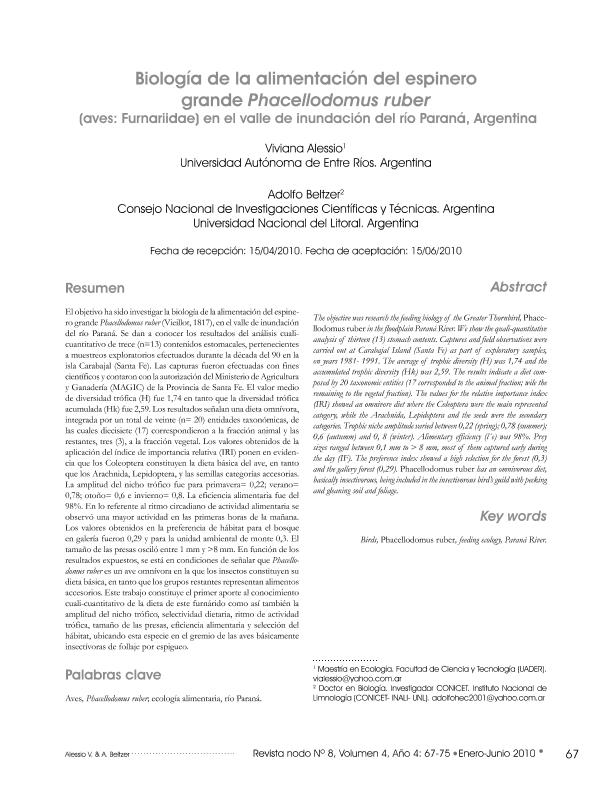Artículo
Biología de la alimentación del espinero grande Phacellodomus ruber (aves: Furnariidae) en el valle de inundación del río Paraná, Argentina
Fecha de publicación:
01/2010
Editorial:
Universidad Antonio Nariño
Revista:
Revista Nodo
ISSN:
1909-3888
Idioma:
Español
Tipo de recurso:
Artículo publicado
Clasificación temática:
Resumen
The objective was research the feeding biology of the Greater Thornbird, Phace-llodomus ruber in the floodplain Paraná River. We show the quali-quantitative analysis of thirteen (13) stomach contents. Captures and field observations were carried out at Carabajal Island (Santa Fe) as part of exploratory samples, on years 1981- 1991. The average of trophic diversity (H) was 1,74 and the accumulated trophic diversity (Hk) was 2,59. The results indicate a diet com-posed by 20 taxonomic entities (17 corresponded to the animal fraction; wile the remaining to the vegetal fraction). The values for the relative importance index (IRI) showed an omnivore diet where the Coleoptera were the main represented category, while the Arachnida, Lepidoptera and the seeds were the secondary categories. Trophic niche amplitude varied between 0,22 (spring); 0,78 (summer); 0,6 (autumm) and 0, 8 (winter). Alimentary efficiency (l´e) was 98%. Prey sizes ranged between 0,1 mm to > 8 mm, most of them captured early during the day (IF). The preference index showed a high selection for the forest (0,3) and the gallery forest (0,29). Phacellodomus ruber has an omnivorous diet, basically insectivorous, being included in the insectivorous bird’s guild with pecking and gleaning soil and foliage.
Palabras clave:
Phacellodomus ruber
,
feeding ecology
,
Paraná medio
Archivos asociados
Licencia
Identificadores
Colecciones
Articulos(INALI)
Articulos de INST.NAC.DE LIMNOLOGIA (I)
Articulos de INST.NAC.DE LIMNOLOGIA (I)
Citación
Alessio, Viviana Graciela; Beltzer, Adolfo Hector; Biología de la alimentación del espinero grande Phacellodomus ruber (aves: Furnariidae) en el valle de inundación del río Paraná, Argentina; Universidad Antonio Nariño; Revista Nodo; 4; 8; 1-2010; 67-75
Compartir




